VIDEO: 7 Summer Lawn Weeds in Central & Southern Maryland (and How to Kill Them)
In the heat of the summer months, you think you’d be past the worst of lawn weeds.
But those little rascals happen to love the heat and humidity. So as temperatures rise, weeds continue their rampage.
What’s more, summer lawn weeds can even be drought tolerant, meaning a lack of rain won’t bother them at all.
Great. Just what you need: more weeds ruining your picture perfect yard, making it look neglected and unkempt.
Well, enough’s enough. Let’s look at the 7 worst summer lawn weeds in Central and Southern Maryland and how to get rid of them so you can return to summer fun.
7 Summer Lawn Weeds You Hope You Don’t See in Your Maryland Lawn
Summer lawn weeds don’t belong to a special club, but they do have this knack for surviving on little water and exploding in hot, humid conditions.
Also, many summer lawn weeds aren’t always easy to control once they’ve settled into your yard, so you have to know what you’re dealing with in order to zap these ugly invaders from your lawn.
1. Crabgrass
Crabgrass starts germinating in the soil during the spring. But, especially if left uncontrolled, it rears its ugly head in June and July.
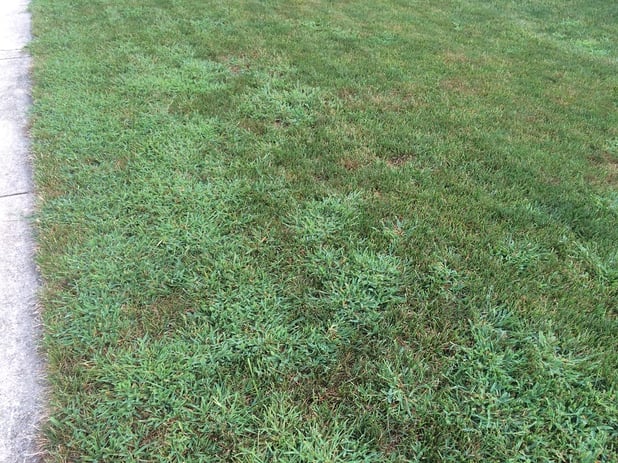 Crabgrass is the monster of summer lawn weeds. It boldly bursts into thin, weak lawns that don’t receive enough water or nutrients, taking over where it can. And, boy, is it aggressive; in fact, each plant can produce 75,000 seeds.
Crabgrass is the monster of summer lawn weeds. It boldly bursts into thin, weak lawns that don’t receive enough water or nutrients, taking over where it can. And, boy, is it aggressive; in fact, each plant can produce 75,000 seeds.
Thick crabgrass patches can even bully out weak lawn patches and then leave bare areas in its wake that you have to tend to later with some lawn seed. The numerous crabgrass seeds and weakening of the lawn only exacerbate the problem come next spring and summer.
Use This Lawn Weed ID Tool to Spot Weeds in Your Lawn
This is the only weed on the list where pre-emergent weed control is the best way to get a head start on stopping crabgrass before it starts. However, it’s common to have breakthroughs along lawn edges or in thin spots. Post-emergent crabgrass control can help with this.
2. Dallisgrass
What looks a little like crabgrass but is a more tenacious summer lawn weed? Dallisgrass. Why? Because, unlike crabgrass, it's perennial, meaning it comes back each year. And right now it’s going to seed and grow thicker and plumper and more upright than its crabgrass cousin.
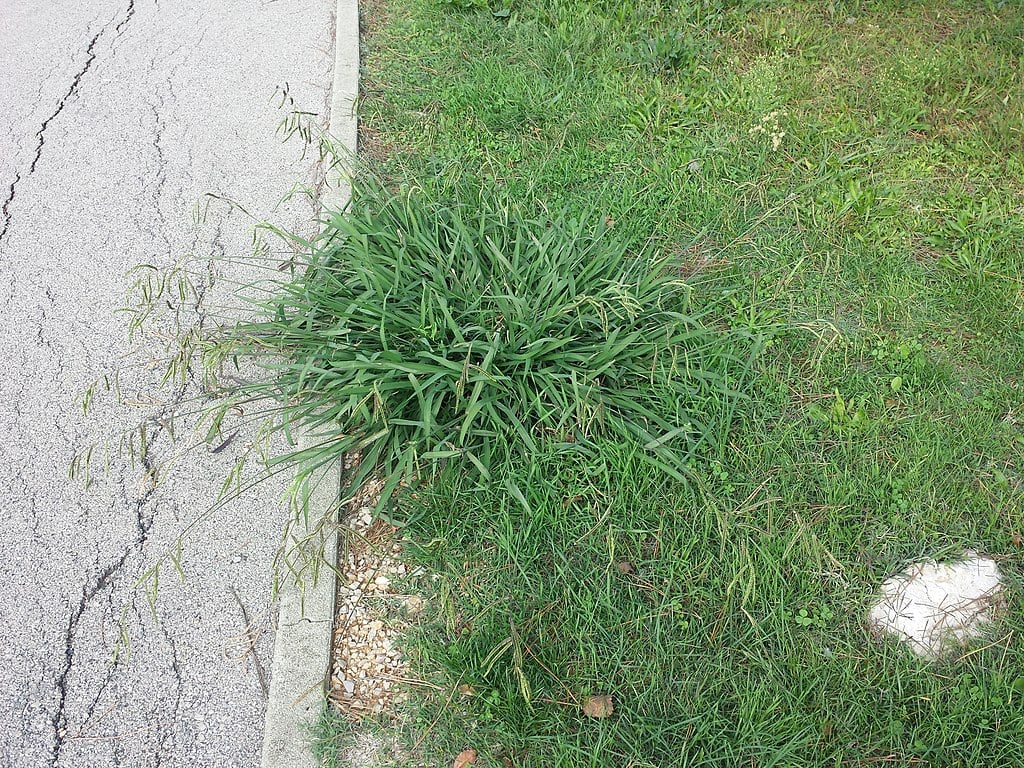 Another differentiator: The Dallisgrass leaf blades are yellow-green and have a white vein running down the center.
Another differentiator: The Dallisgrass leaf blades are yellow-green and have a white vein running down the center.
3. Nutsedge
While nutsedge looks like a grass with its shiny, yellow-green, narrow blades, it’s actually considered a sedge, spreading by offshoots as well as seed.
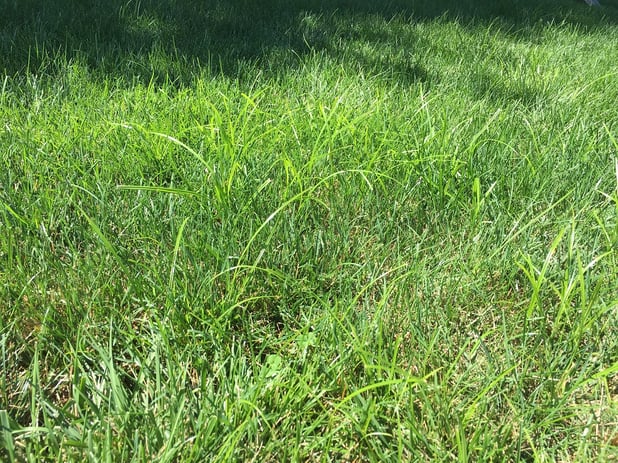
Nutsedge loves wet areas with poor drainage. And its extensive underground network keeps this summer lawn weed growing and growing. One nutsedge plant can produce 1,900 shoots and 6,900 tubers in just one year.
4. Spotted Spurge
Spotted spurge is just that: red dots on dark green, circular leaves that branch out from a central point on hairy, red stems. In addition to the signature spots, spotted spurge emits a milky sap when any part of the plant is damaged.
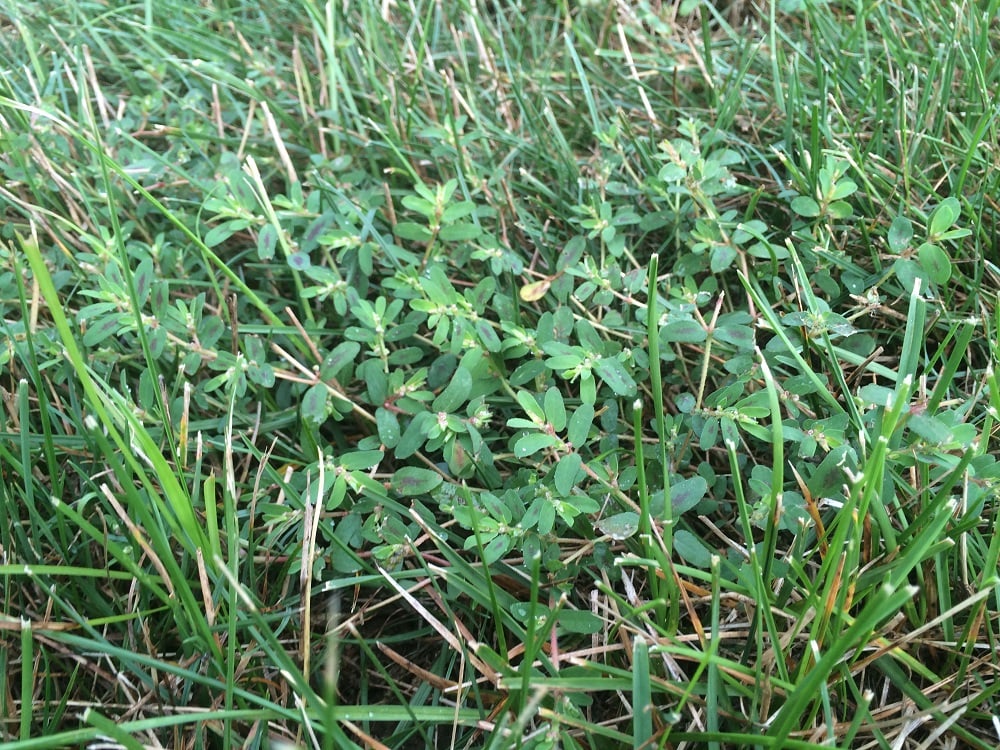 Like other summer lawn weeds, spotted spurge can produce several thousand seeds per plant and quickly spread through the weaker areas of your lawn.
Like other summer lawn weeds, spotted spurge can produce several thousand seeds per plant and quickly spread through the weaker areas of your lawn.
5. Lespedeza
Lespedeza is a summer lawn weed that looks a little bit like clover with its three smooth, dark green, oblong leaves and small pinkish purple flowers. In fact, it’s also known as Japanese clover.
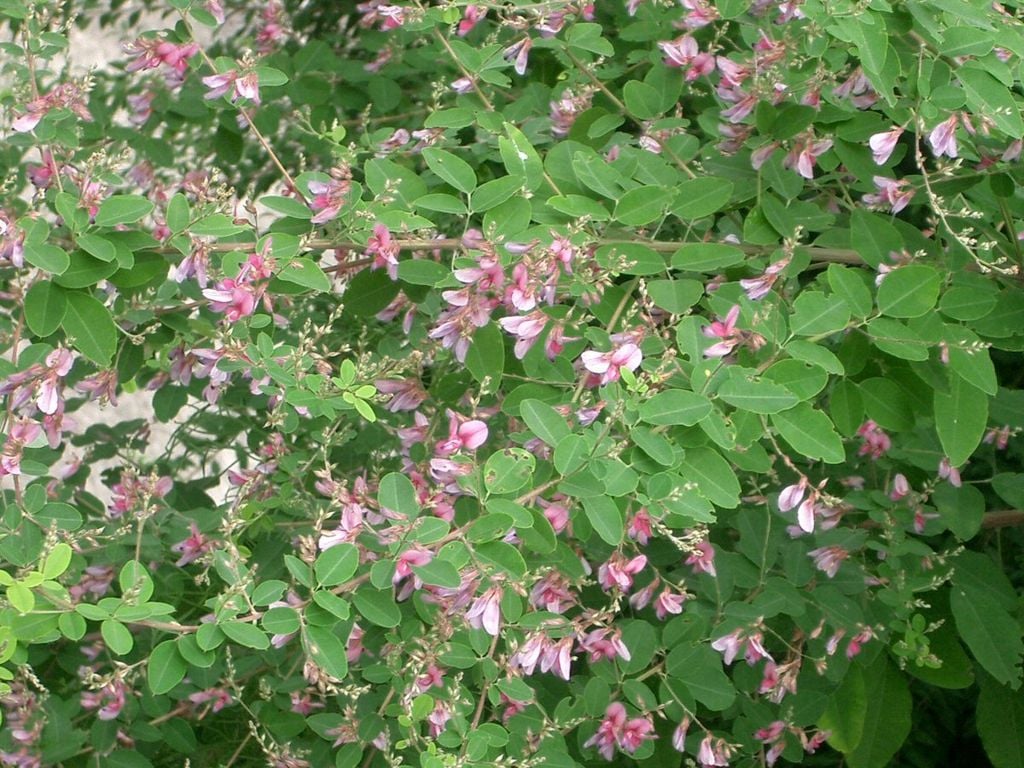 When your lawn slows growth in summer, weeds like lespedeza survive even in harsh conditions. Lespedeza is an annual weed so it dies in winter, reproducing by seed again the following year.
When your lawn slows growth in summer, weeds like lespedeza survive even in harsh conditions. Lespedeza is an annual weed so it dies in winter, reproducing by seed again the following year.
6. Oxalis
Oxalis, also known as Yellow Woodsorrel, is a perennial weed that you can usually first recognize when it’s producing yellow flowers from May through September. Oxalis leaves are clover-like, which means they have three, heart-shaped leaflets.
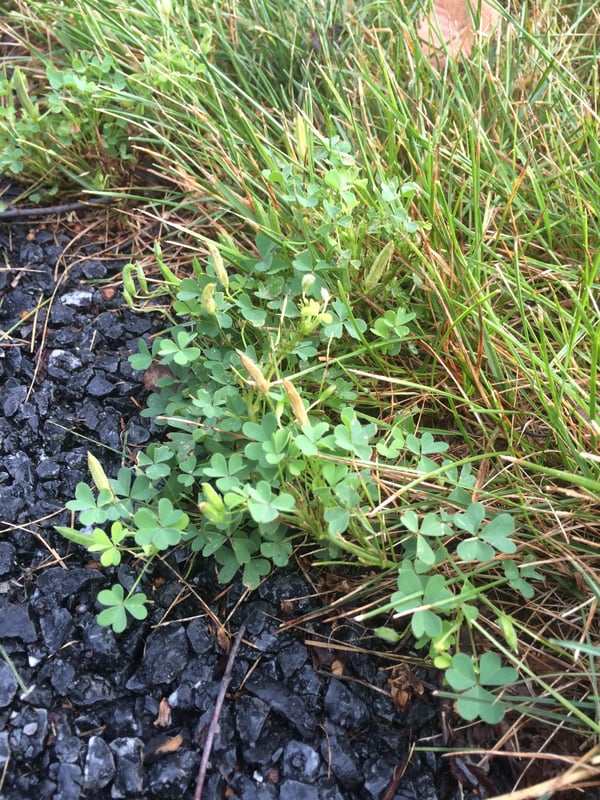
Oxalis has a unique way of spreading seed. Seeds form on capsules that explode when ripe, ejecting seeds as far away as 12 feet away. Now you know how this summer lawn weed spreads so aggressively.
7. Black Medic
Black Medic germinates in late spring, grows well during summer’s heat and then dies off in the cold weather.
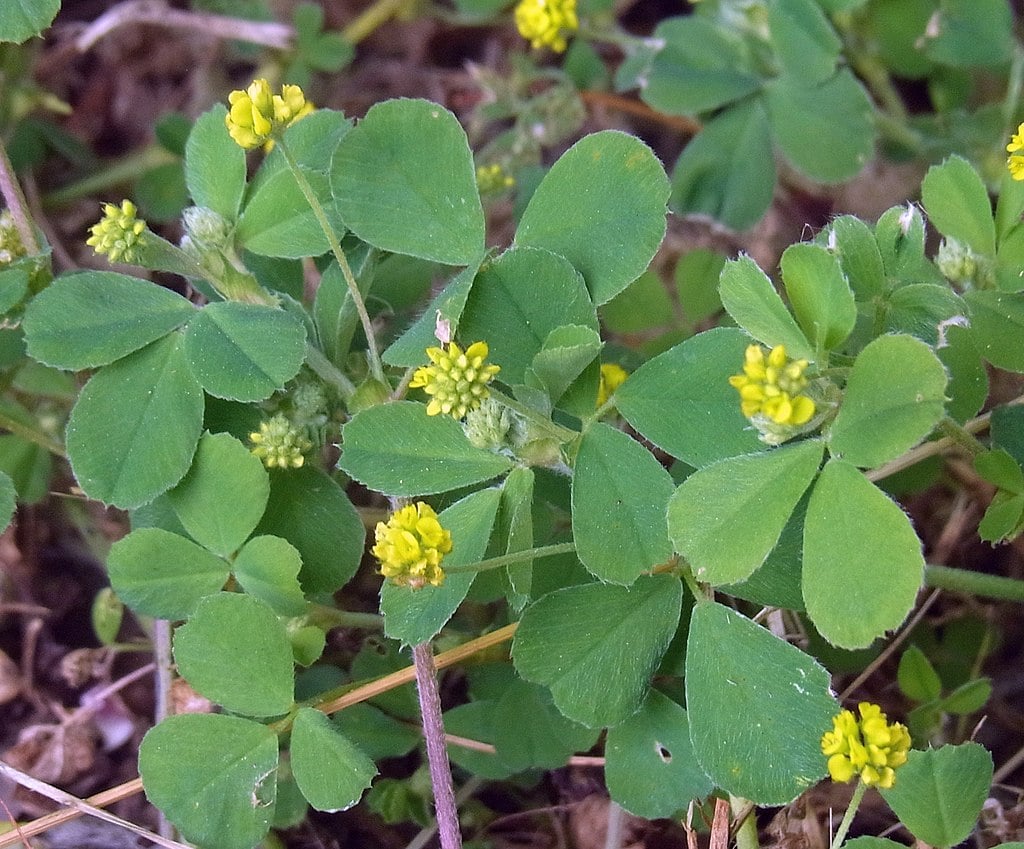 This summer lawn weed likes to fill in bare areas as temperatures rise in Central and Southern Maryland. And it grows low, so it practically sneaks into the lawn and hides out, secretly thriving.
This summer lawn weed likes to fill in bare areas as temperatures rise in Central and Southern Maryland. And it grows low, so it practically sneaks into the lawn and hides out, secretly thriving.
Summer Lawn Weed Control Tips and Tricks
As you can probably tell, weeds like to take advantage of every opportunity for attack and control. Their biggest target is a weak lawn that lacks nutrients, lacks drainage, and is thin and stressed. Add to that some heat, humidity, and the slower growth of your lawn during the summer months, and summer lawn weeds see a party.

Your biggest defense against summer lawn weeds is a healthy, happy lawn. This is a lawn that is mowed regularly to 3.5 to 4 inches high; has the proper balance of nutrients via regular fertilization; receives longer, infrequent irrigation; and is balanced with aeration and overseeding at least once annually. You’re trying to create the best environment for your lawn to grow, not letting weed seeds germinate and emerge.
But weeds can still occasionally break through. While pre-emergent control can help with crabgrass, the other weeds on this list can be tackled with a post-emergent control. But this is best delivered by a professional, and here’s why: A weed like spotted spurge, for instance, has thousands of fine hairs on its leaves, meaning herbicides won’t adequately stick to it. This is a summer lawn weed’s greatest defense mechanism. So lawn care professionals will use specialty herbicides delivered with a specific type of nozzle that reduces the product’s particle size, enabling it to better stick to the weed.
We Can Help You Battle Summer Lawn Weeds
As we said, weeds are opportunistic … they love to invade when conditions signal the green light to let them in. However, sometimes Mother Nature will give them even just a sliver of a chance to breakthrough with a mix of the perfect conditions. This always seems to happen in summer when rain is infrequent and temperatures are hot. And, before you know it, summer lawn weeds are growing and growing.
Natural Green can help you by offering a complete, proactive lawn care program that includes proper fertilization, as well as both pre-emergent and post-emergent weed control treatments throughout the growing season. Even the hottest, driest conditions won’t give weeds a chance when you choose to have a professional eye on your property regularly, keeping weeds in check.
Summer lawn weeds got you feeling down, hiding inside instead of enjoying the sunshine in your yard? We’d love to help. Get started today with a free quote. Together, we’ll prepare a customized plan so you can take back control of your lawn.
Image sources: dalligrass, lespedeza, oxalis, black medic
In the heat of the summer months, you think you’d be past the worst of lawn weeds.
But those little rascals happen to love the heat and humidity. So as temperatures rise, weeds continue their rampage.
What’s more, summer lawn weeds can even be drought tolerant, meaning a lack of rain won’t bother them at all.
Great. Just what you need: more weeds ruining your picture perfect yard, making it look neglected and unkempt.
Well, enough’s enough. Let’s look at the 7 worst summer lawn weeds in Central and Southern Maryland and how to get rid of them so you can return to summer fun.
7 Summer Lawn Weeds You Hope You Don’t See in Your Maryland Lawn
Summer lawn weeds don’t belong to a special club, but they do have this knack for surviving on little water and exploding in hot, humid conditions.
Also, many summer lawn weeds aren’t always easy to control once they’ve settled into your yard, so you have to know what you’re dealing with in order to zap these ugly invaders from your lawn.
1. Crabgrass
Crabgrass starts germinating in the soil during the spring. But, especially if left uncontrolled, it rears its ugly head in June and July.
 Crabgrass is the monster of summer lawn weeds. It boldly bursts into thin, weak lawns that don’t receive enough water or nutrients, taking over where it can. And, boy, is it aggressive; in fact, each plant can produce 75,000 seeds.
Crabgrass is the monster of summer lawn weeds. It boldly bursts into thin, weak lawns that don’t receive enough water or nutrients, taking over where it can. And, boy, is it aggressive; in fact, each plant can produce 75,000 seeds.
Thick crabgrass patches can even bully out weak lawn patches and then leave bare areas in its wake that you have to tend to later with some lawn seed. The numerous crabgrass seeds and weakening of the lawn only exacerbate the problem come next spring and summer.
Use This Lawn Weed ID Tool to Spot Weeds in Your Lawn
This is the only weed on the list where pre-emergent weed control is the best way to get a head start on stopping crabgrass before it starts. However, it’s common to have breakthroughs along lawn edges or in thin spots. Post-emergent crabgrass control can help with this.
2. Dallisgrass
What looks a little like crabgrass but is a more tenacious summer lawn weed? Dallisgrass. Why? Because, unlike crabgrass, it's perennial, meaning it comes back each year. And right now it’s going to seed and grow thicker and plumper and more upright than its crabgrass cousin.
 Another differentiator: The Dallisgrass leaf blades are yellow-green and have a white vein running down the center.
Another differentiator: The Dallisgrass leaf blades are yellow-green and have a white vein running down the center.
3. Nutsedge
While nutsedge looks like a grass with its shiny, yellow-green, narrow blades, it’s actually considered a sedge, spreading by offshoots as well as seed.

Nutsedge loves wet areas with poor drainage. And its extensive underground network keeps this summer lawn weed growing and growing. One nutsedge plant can produce 1,900 shoots and 6,900 tubers in just one year.
4. Spotted Spurge
Spotted spurge is just that: red dots on dark green, circular leaves that branch out from a central point on hairy, red stems. In addition to the signature spots, spotted spurge emits a milky sap when any part of the plant is damaged.
 Like other summer lawn weeds, spotted spurge can produce several thousand seeds per plant and quickly spread through the weaker areas of your lawn.
Like other summer lawn weeds, spotted spurge can produce several thousand seeds per plant and quickly spread through the weaker areas of your lawn.
5. Lespedeza
Lespedeza is a summer lawn weed that looks a little bit like clover with its three smooth, dark green, oblong leaves and small pinkish purple flowers. In fact, it’s also known as Japanese clover.
 When your lawn slows growth in summer, weeds like lespedeza survive even in harsh conditions. Lespedeza is an annual weed so it dies in winter, reproducing by seed again the following year.
When your lawn slows growth in summer, weeds like lespedeza survive even in harsh conditions. Lespedeza is an annual weed so it dies in winter, reproducing by seed again the following year.
6. Oxalis
Oxalis, also known as Yellow Woodsorrel, is a perennial weed that you can usually first recognize when it’s producing yellow flowers from May through September. Oxalis leaves are clover-like, which means they have three, heart-shaped leaflets.

Oxalis has a unique way of spreading seed. Seeds form on capsules that explode when ripe, ejecting seeds as far away as 12 feet away. Now you know how this summer lawn weed spreads so aggressively.
7. Black Medic
Black Medic germinates in late spring, grows well during summer’s heat and then dies off in the cold weather.
 This summer lawn weed likes to fill in bare areas as temperatures rise in Central and Southern Maryland. And it grows low, so it practically sneaks into the lawn and hides out, secretly thriving.
This summer lawn weed likes to fill in bare areas as temperatures rise in Central and Southern Maryland. And it grows low, so it practically sneaks into the lawn and hides out, secretly thriving.
Summer Lawn Weed Control Tips and Tricks
As you can probably tell, weeds like to take advantage of every opportunity for attack and control. Their biggest target is a weak lawn that lacks nutrients, lacks drainage, and is thin and stressed. Add to that some heat, humidity, and the slower growth of your lawn during the summer months, and summer lawn weeds see a party.

Your biggest defense against summer lawn weeds is a healthy, happy lawn. This is a lawn that is mowed regularly to 3.5 to 4 inches high; has the proper balance of nutrients via regular fertilization; receives longer, infrequent irrigation; and is balanced with aeration and overseeding at least once annually. You’re trying to create the best environment for your lawn to grow, not letting weed seeds germinate and emerge.
But weeds can still occasionally break through. While pre-emergent control can help with crabgrass, the other weeds on this list can be tackled with a post-emergent control. But this is best delivered by a professional, and here’s why: A weed like spotted spurge, for instance, has thousands of fine hairs on its leaves, meaning herbicides won’t adequately stick to it. This is a summer lawn weed’s greatest defense mechanism. So lawn care professionals will use specialty herbicides delivered with a specific type of nozzle that reduces the product’s particle size, enabling it to better stick to the weed.
We Can Help You Battle Summer Lawn Weeds
As we said, weeds are opportunistic … they love to invade when conditions signal the green light to let them in. However, sometimes Mother Nature will give them even just a sliver of a chance to breakthrough with a mix of the perfect conditions. This always seems to happen in summer when rain is infrequent and temperatures are hot. And, before you know it, summer lawn weeds are growing and growing.
Natural Green can help you by offering a complete, proactive lawn care program that includes proper fertilization, as well as both pre-emergent and post-emergent weed control treatments throughout the growing season. Even the hottest, driest conditions won’t give weeds a chance when you choose to have a professional eye on your property regularly, keeping weeds in check.
Summer lawn weeds got you feeling down, hiding inside instead of enjoying the sunshine in your yard? We’d love to help. Get started today with a free quote. Together, we’ll prepare a customized plan so you can take back control of your lawn.
Image sources: dalligrass, lespedeza, oxalis, black medic


